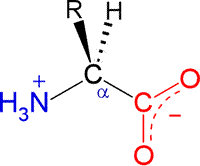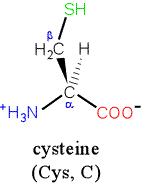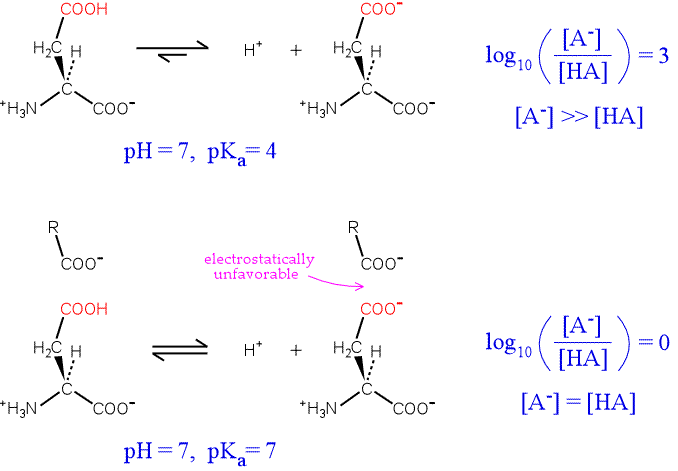Lecture 5. Amino acids
Monday 12 September 2016
General structure of α-amino acids. The set of 20 "standard" amino acids Assignment of configuration to chiral centers: Relative and absolute. Chiral side chains. Some notable features of selected amino acids. Histidine: An "ambidextrous" amino acid residue. pKa values. Intrinsic vs. perturbed pKas. Amino acid modifications and derivatives. Glutathione.
Reading: VVP4e - Ch.4, pp.76-90.
Summary

The general structural formula for an α-amino acid, shown at right, contains the amino and carboxyl functional groups as substituents of a single carbon atom designated as C-alpha (Cα). These groups are shown in their expected ionization state at a physiological pH of about 7. The other two substituents of Cα are the alpha hydrogen (Hα) and a variable substituent denoted as R. When the latter is not hydrogen (nor amino or carboxyl), Cα is a chiral center. Thus the figure represents an L configuration, according to the relative configuration assignment convention. This matches the chiral configuration of the naturally-occurring α-amino acids, although exceptions are not unknown. We ususally think of the natural α-amino acids as comprising a set of 20 that are encoded by nucleotide triplets and incorporated into ribosomally-synthesized polypeptides and proteins. Again, we now know of some minor, yet interesting, exceptions. The figure below shows the structural formulas for each member of the set of 20 "standard" amino acids, shown using the bond-line format. The arrangement of the structures in the figure reflects certain similarities. the two amino acids at the top left, serine (S) and threonine (T), both contain the hydroxyl functional group. Glycine (G) and proline (P) are unique in terms of chirality (Gly is achiral) and the conformational flexibility they confer upon the polypeptide chain that incorporates them. Proline could be considered to have a nonpolar character, so it is shown adjacent to the other amino acids with nonpolar hydrocarbon R groups - alanine (A), isoleucine (I), valine (V), leucine (L). Cysteine (C) and methionine (M) are the two sulfur-containing amino acids; phenylalanine (F), tyrosine (Y) and tryptophan (W) are aromatic; histidine (H), lysine (K) and arginine (R) are basic and shown in order of increasing basicity. The acidic amino acids aspartate (D) and glutamate (E), are shown together, along with their amides, asparagine (N) and glutamine (Q).

By convention, a polypeptide sequence can be represented by the single letter symbol for an amino acid, with the first letter listed the amino end or at the N-terminus and the last letter listed the carboxy end or C-terminus.
Glycine
Glycine (Gly, G) is the simplest of the 20 naturally-occurring amino acids. As noted above, since R is just a hydrogen, glycine is the only natural amino acid that is not chiral at the alpha carbon. Although in some classification schemes, glycine is considered nonpolar, hydrogen is so small that it contributes negligibly to nonpolar surface area. It is much more significant that the smallness of its hydrogen R group offers relatively little steric hindrance to bond rotations at Cα and thus the presence of Gly confers greater conformational flexibility in the context of a polypeptide chain.
Histidine
Histidine (His, H) is one of the most interesting amino acids because of the variety of roles it can play in protein function, especially as a key residue in many enzyme active sites. Of all the ionizable side chains, the typical pKa of the imidazole ring of His is closest to a neutral pH. Studies of model compounds have established a range of 6.0 - 7.0 for the intrinsic pKa of the histidine side chain.

The neutral form of the imidazole ring can exist in two different tautomeric forms: with hydrogen on the δ1 nitrogen or with hydrogen on the ε2 nitrogen. The pKa of the ε2 nitrogen has been shown in 13-C NMR studies of a model compound to be about 0.6 pH units higher than that of the δ1 nitrogen, so in the absence of countervailing environmental effects, the form on the right will tend to predominate.

Neutral imidazole is a particularly good nucleophile, and histidine is one of the more reactive residues in proteins. With a pKa near 7, the imidazole side chain is one of the strongest bases that can exist at neutral pH. In its neutral form, the imidazole side chain has an "ambidextrous" nature, since the nitrogen without a hydrogen is nucleophilic and can act as a hydrogen bond acceptor, while the nitrogen with the hydrogen bond is electrophilic and can act as a H-bond donor.

Protonation of a histidine residue inactivates it as a nucleophile. The protonated form of the imidazole ring is stabilized by resonance, by which the positive charge is shared by both nitrogen atoms of the ring.
A prominent example of histidine as a crucial catalytic component in an enzyme mechanisms found in the serine proteases. Histidine is the central residue in a catalytic triad that is characteristic of this type of enzyme. A neutral imidazole acts as a base to enhance the power of serine as a nucleophile to attack the acyl carbon of a peptide bond to form a tetrahedral intermediate. The protonated His residue in turn acts as a proton donor (general acid) to promote the loss of a leaving group from a tetrahedral intermediate.
Cysteine
Cysteine (Cys, C), one of two sulfur-containing amino acids, bears the most reactive side chain, a thiol (-SH, also called sulfhydryl) group attached to the beta carbon. The thiol is weakly acidic (intrinsic pKa 9.0-9.5), its the dissociation leaves the thiolate anion. Both of these, particularly thiolate, are good nucleophiles, so the cysteine side chain can engage in many substitution reactions. Other reactions involve the oxidation of the thiol group.
 The nucleophilic thiol group can be alkylated by reaction with alkyl halides or iodoacetate.
Another common reaction, especially important one for cysteine's biological role in protein function,
is the formation of a thioester linkage (formally a carboxylic acid derivative).
The nucleophilic thiol group can be alkylated by reaction with alkyl halides or iodoacetate.
Another common reaction, especially important one for cysteine's biological role in protein function,
is the formation of a thioester linkage (formally a carboxylic acid derivative).
A disulfide bond is a covalent chemical bond between two sulfur atoms that can arise from the oxidative linking of two sulfhydryl (thiol) groups. This is a common theme for cysteine residues in proteins, especially those in oxidizing environments such as prevailing extracellular conditions. The formation of disulfide bonds within proteins in vivo is a common example of a posttranslational modification.
 Shown at right are two cysteine residues in polypeptide chain(s).
The thiol groups are in their reduced forms (in red in figure).
Removal of two hydrogens (H+ + e−) from each thiol
(by an oxidizing agent, not included in the figure, which represents an oxidation half-reaction),
and concomitant formation of a new covalent bond - the disulfide bond -
between the two sulfur atoms yields the lower structure at right.
A disulfide-linked pair of cysteine residues is termed a cystine residue.
The conversion of two sulfhydryl groups to a disulfide
linkage is an oxidation reaction. Conversely, disulfide bonds can
be reduced to yield two thiols, which is the reverse of the half-reaction shown at right.
Reagents used to break disulfides notably include other thiol-containing species, such as
β-mercaptoethanol (mercaptan is yet another name for the thiol group) and
glutathione. The reduced thiols undergo a disulfide exchange reaction with disulfide-linked species.
Shown at right are two cysteine residues in polypeptide chain(s).
The thiol groups are in their reduced forms (in red in figure).
Removal of two hydrogens (H+ + e−) from each thiol
(by an oxidizing agent, not included in the figure, which represents an oxidation half-reaction),
and concomitant formation of a new covalent bond - the disulfide bond -
between the two sulfur atoms yields the lower structure at right.
A disulfide-linked pair of cysteine residues is termed a cystine residue.
The conversion of two sulfhydryl groups to a disulfide
linkage is an oxidation reaction. Conversely, disulfide bonds can
be reduced to yield two thiols, which is the reverse of the half-reaction shown at right.
Reagents used to break disulfides notably include other thiol-containing species, such as
β-mercaptoethanol (mercaptan is yet another name for the thiol group) and
glutathione. The reduced thiols undergo a disulfide exchange reaction with disulfide-linked species.
Perturbed or "anomalous" pKa values
As has already been suggested, the intrinsic pKa values for ionizable groups are no guarantee that a particular residue in a particular protein will be in a particular ionization state at a pH consistent with its physiologically relevant structure and function. Some pKa values are perturbed significantly from their intrinsic values, and these "anomalous" values are furthermore demonstrably important for the proper function of a protein in some cases.
To illustrate the idea, consider an aspartate residue in a neutral (pH 7) aqueous environment with a "normal" pKa. The residue will be overwhelmingly ionized. By plugging in values for the pKa of the residue, the pH of the medium, the Henderson-Hasselbalch equation can be used to calculate the proportion of ionized to unionized forms of the residue. The top half of the figure below illustrates the situation.

Now consider the influence of a nearby negative charge on the ionization of our hypothetical residue. The presence of the negative charge makes the ionization much less favorable, shifting the equilibrium to the left. The greater the shift in the equilibrium, the more the pKa is raised from its intrinsic value. In the extreme case illustrated, the amounts of both forms of the residue are equal, and the pKa has been perturbed upward by three units.
An example of this effect where the residue with an anomalous pKa is directly involved in the protein's function is provided by lysozyme. Lysozyme is an enzyme produced by a variety of organisms that hydrolyzes the polysaccharide component of the peptidoglycan cell walls of many types of bacteria. The mechanism of lysozyme depends on two acidic residues, Asp52 and Glu35. Asp52 has a normal pKa. Its negative charge stabilizes a developing positive charge as the reaction proceeds through a oxonium ion intermediate. However, Glu35 has an anomalously high pKa (its pKa is thought to be about 6.5), keeping it more in the protonated form. The unionized form of Glu35 donates a hydrogen ion to the oxygen of the glycosidic linkage, assisting the breaking of the bond between sugar residues. Glu35 would not be so effective in this role if its pKa was normal.
Amino acid derivatives
Tyrosine can be readily derived from phenylalanine by hydroxylation of the latter. Thus, while phenylalanine is an essential amino acid, tyrosine is not. Further hydroxylation of tyrosine, combined with its decarboxylation leads to the catecholamine neurotransmitter dopamine, which in can be further derivatized to norepinephrine and epinephrine.
Posttranslational modifications of amino acid residues
Phosphorylation and glycosylation are very common posttranslational modifications. The most commonly phosphorylated residues in proteins are serine, threonine, and tyrosine. There are very many types of posttranslational modifications. Some other notable examples are the hydroxylation of proline, which is crucial in collagen, and the carboxylation of glutamate to form γ-carboxyglutamate, particularly adept at chelating Ca2+, which is important to the cascade of protein factor activation in blood clotting.
A particularly dramatic (and colorful!) example of posttranslational modification is the green fluorescent protein (GFP), a bioluminescent jellyfish protein. GFP undergoes a spontaneous reaction that converts a three-residue sequence, Ser-Tyr-Gly, into a fluorophore.